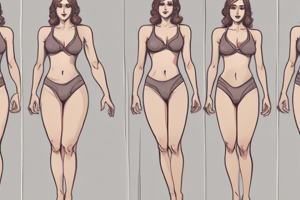Podcast
Questions and Answers
Which body type is characterized by a slow metabolism and a stocky build?
Which body type is characterized by a slow metabolism and a stocky build?
- Endomorph (correct)
- Athletic
- Ectomorph
- Mesomorph
What is the optimum BMI range classified for a healthy individual?
What is the optimum BMI range classified for a healthy individual?
- Overweight - 25 – 29.9
- Underweight - Less than 18.5
- Class I obesity - 30 – 34.9
- Optimum range - 18.5 – 20.9 (correct)
Which type of fitness primarily assesses how well a person can perform sports-related skills?
Which type of fitness primarily assesses how well a person can perform sports-related skills?
- Cardiovascular Fitness
- Health-Related Fitness
- Muscular Fitness
- Skill-Related Fitness (correct)
Which nutrient is recommended for consumption before a workout to provide energy?
Which nutrient is recommended for consumption before a workout to provide energy?
Which exercise type is aimed at improving cardiovascular endurance?
Which exercise type is aimed at improving cardiovascular endurance?
Which of the following is NOT a common weight loss myth?
Which of the following is NOT a common weight loss myth?
Which component of fitness relates to how long a muscular contraction can be maintained?
Which component of fitness relates to how long a muscular contraction can be maintained?
What is the primary purpose of dance as mentioned in the content?
What is the primary purpose of dance as mentioned in the content?
Flashcards are hidden until you start studying
Study Notes
Body Types
- Ectomorph: Characterized by a fast metabolism, thin physique, and flat chest.
- Mesomorph: Naturally athletic individuals who find it easy to gain muscle.
- Endomorph: Noted for a slow metabolism, often with a stocky build.
Fitness Categories
- Physical Fitness: Confidence in performing activities without fatigue.
- Health-Related Fitness: Assesses overall health status through various factors:
- Cardiovascular endurance
- Muscular strength
- Muscular endurance
- Flexibility
- Body composition
- Skill-Related Fitness: Focuses on athletic capabilities:
- Balance
- Coordination
- Reaction time
- Power
- Speed
- Agility
Body Mass Index (BMI)
- Underweight: Less than 18.5
- Optimum range: 18.5 – 20.9
- Overweight: 25 – 29.9
- Class I obesity: 30 – 34.9
- Class II obesity: 35 – 39.5
- Class III obesity: More than 40
Dance
- Defined as rhythmic movement of the body.
- Functions to express feelings, emotions, and ideas.
- Provides a means to release energy.
Types of Exercise
- Strength Training: Building muscle strength through resistance.
- Aerobic Training: Enhancing cardiovascular fitness.
Macronutrients
- Carbohydrates: Key source of energy pre-workout.
- Protein: Essential for muscle growth and repair post-workout.
- Fats: Important for overall nutrition balance.
Micronutrients
- Vitamins: Support various body functions.
- Minerals: Important for bone and muscle health.
- Antioxidants: Protect body from oxidative stress.
Workout Timing
- Before Workout: Carbohydrates provide energy.
- During Workout: Maintain energy levels.
- After Workout: Protein aids recovery and muscle growth.
Weight Loss Myths
- Misconceptions include targeting fat loss, meal skipping, and relying solely on cardio for weight management.
Exercise Framework (B.A.S.T.E)
- B - Body: The vehicle for action.
- A - Action: Movements can be locomotor (moving) or non-locomotor (stationary).
- S - Space: Awareness of physical space during movement.
- T - Time: Dancing actions have duration and timing.
- E - Energy: Quality and intensity of motion.
Additional Notes
- Consider the balance of nutrition, exercise, and rest for optimal performance and health.
Studying That Suits You
Use AI to generate personalized quizzes and flashcards to suit your learning preferences.




